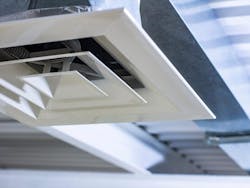LETTER: New Ventilation Guidelines Neglect Geometry
Re the May/June 2023 cover story, Big News: CDC Key Recommendations for Improving Ventilation in Buildings:
Dear Editor,
As a member of the HPAC Editorial Advisory Board, I feel I have an obligation to point out that the CDC ventilation recommendation is based merely on air changes per hour, with no mention of the geometry of the air movement through the occupied space. This can have a huge impact on the effectiveness of the ventilation being provided.
For example, in the all-too-familiar design for mixed air ventilation, both the locations for air entering the space and leaving the space are located in the ceiling. This design is not resilient or fail safe. Should the situation arise where the supply air is not being cooled, the clean air will stay aloft until drawn away by its nearest exhaust grille. This failure to cool the supply air can be due to either design, equipment failure, or a major power outage during a heat wave.
In one investigation I performed in an elementary school during a hot spell in May of its first year of occupancy, this was what I found. While four air changes per hour of ventilation were reported as being provided, all this air movement was near the ceiling. Nearer to the floor, where the children were, it was so stifling that one student was sent to the hospital as a precaution.
And this was pre-pandemic.
If the placement of both the supply and exhaust locations in the ceiling is to be avoided, a preferable geometry would have the SA introduced low in the space, while the exhaust air to be removed would be as high in the space as possible. This air movement geometry is called displacement ventilation.
To increase resiliency, the exhaust could be augmented by using solar energy to increase thermal buoyancy of the air leaving the building. That way, should there be a power outage during an extended heat wave, embracing natural ventilation forces would achieve some air movement through the building as opposed to stifling conditions.
David W. Bearg, PE
Life Energy Associates
Concord MA
